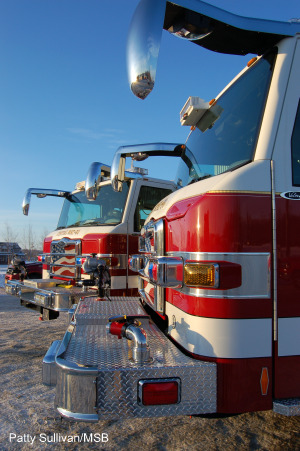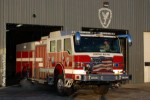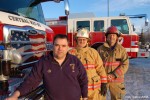
MAT-SU—Two state-of-the-art fire engines with compressed air foam capability are being outfitted at the Central MAT-SU Public Safety building. The engines will help firefighters knock down fires faster and ultimately save more property.
The fire engines are equipped with four-wheel drive to maintain traction on icy roads; heated front mirrors that require a glance rather than a turn of the head; and a full compressed air foam capability that increases firefighting efforts five times over.
“Last year our calls increased 13.35 percent over the previous year,” said Central Fire Chief James Steele. The quickly growing community of Knik-Fairview is within Central's boundaries.
Central MAT-SU Fire Department is the second largest in Alaska. The population in the Wasilla-Lakes Fire Service Area has grown quickly in recent years. The new rigs will help offer better fire protection coverage.

The engines cost $530,000 and were purchased by taxpayers of the Wasilla-Lakes FSA.
The engines will be instrumental in wildland/urban interface fires, where forest fires meet homes. With its two pump system, the fire engine can pump 1,500 gallons of water a minute and can also pump 100 gallons of fire suppressing foam a minute while the engine is rolling. A firefighter can aim the turret gun from inside the engine. The pump and roll feature saves precious minutes over the traditional fire engine, which must be put in gear, set up, pumped, then broken down.
“In the Miller's Reach (fire) if we had something like this we could have gone up to one structure, coated it in foam, driven to the next house, coated it in foam,” Steele said. “In those situations, seconds were what counted.”

The Miller's Reach Fire in 1996 was a wildland/urban interface fire, the most destructive fire in Alaska's history, burning 443 buildings, most of them homes.
The engine also protects firefighters during vehicle rollovers. Side airbag curtains are among the features. The rig stands higher off the ground than an older engine in the same bay.
“There's some driveways where this (older) engine won't go up,” Central's Deputy Fire Chief Michael Keenan said. “This one will go up,” he said, pointing out the heavy tread of tires that will engage in four-wheel drive.
Keenan said the compressed air-foam system will maximize the effectiveness of the 700 gallons of water on board. “It will increase the firefighter capabilities by five compared to water alone. That's five times the 700 gallons of water.”
The special foam will also shorten the amount of time it takes to knock down a fire, which can preventing smoke damage and require less water to be put on the fire, saving more property overall.
The compressed air foam can be supplied to multiple hoselines at once or through the turret. These are the first two fully capable compressed air foam apparatus in the MAT-SU.

On this new engine the engineer's compartment, where the fire hoses are kept, is enclosed and heated, helping the engine withstand sustained sub-zero temperatures. This same compartment on traditional engines is exposed to the elements and more likely to freeze up.
For more information call Central Chief James Steele at 373-8805 or Public Affairs Director Patty Sullivan at 745-9577.
Photos by Patty Sullivan. Top image: Capt. Jon Burns pulls the new engine out of station 6-1. Middle image: Deputy Chief for Central MAT-SU Michael Keenan, Assistant Chief Mahlon Greene, and Capt. John Burns will be among the drivers of the new engines. Third photo: The side view of the new engines.
—End—

 MAT-SU—Two state-of-the-art fire engines with compressed air foam capability are being outfitted at the Central MAT-SU Public Safety building. The engines will help firefighters knock down fires faster and ultimately save more property.
MAT-SU—Two state-of-the-art fire engines with compressed air foam capability are being outfitted at the Central MAT-SU Public Safety building. The engines will help firefighters knock down fires faster and ultimately save more property.
 The engines cost $530,000 and were purchased by taxpayers of the Wasilla-Lakes FSA.
The engines cost $530,000 and were purchased by taxpayers of the Wasilla-Lakes FSA. The Miller's Reach Fire in 1996 was a wildland/urban interface fire, the most destructive fire in Alaska's history, burning 443 buildings, most of them homes.
The Miller's Reach Fire in 1996 was a wildland/urban interface fire, the most destructive fire in Alaska's history, burning 443 buildings, most of them homes.

